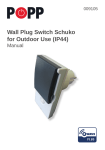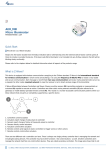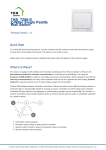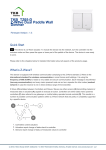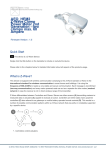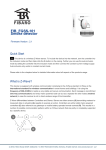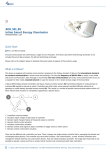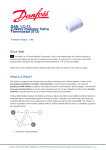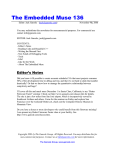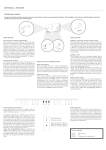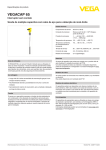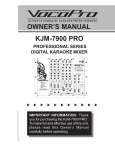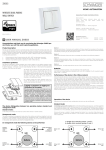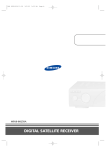Download POP_123610 Z-Wave Wall Plug Switch Schuko - smart
Transcript
POP_123610 Z-Wave Wall Plug Switch Schuko Firmware Version : 1.0 Quick Start A This is a Z-Wave actuator. Inclusion and Exclusion are confirmed by a tripple click of the button. Please refer to the chapters below for detailed information about all aspects of the products usage. What is Z-Wave? This device is equipped with wireless communication complying to the Z-Wave standard. Z-Wave is the international standard for wireless communication in smart homes and buildings. It is using the frequency of 868.42 MHz to realize a very stable and secure communication. Each message is reconfirmed (two-way communication) and every mains powered node can act as a repeater for other nodes (meshed network) in case the receiver is not in direct wireless range of the transmitter. Z-Wave differentiates between Controllers and Slaves. Slaves are either sensors (S) transmitting metered or measured data or actuators (A) capable to execute an action. Controllers are either static mains powered controllers (C) also referred to as gateways or mobile battery operated remote controls (R). This results in a number of possible communication patterns within a ZWave network that are partly or completely supported by a specific device. 1. 2. 3. 4. 5. 6. 7. Controllers control actuators Actuators report change of status back to controller Sensors report change of status of measured values to controller Sensors directly control actuators Actuators control other actuators Remote controls send signals to static controllers to trigger scenes or other actions Remote controls control other actuators. There are two different role a controller can have. There is always one single primary controller that is managing the network and including/excluding devices. The controller may have other functions - like control buttons - as well. All other controllers don't manage the network itself but can control other devices. They are called secondary controllers. The image also shows that its not possible to operate a sensor just from a remote control. Sensors only communicate with static controllers. 1 (c) 2012 Z-Wave Europe GmbH, Goldbachstr. 13, 09337 Hohenstein-Ernstthal, Germany, www.zwaveeurope.com Product description This is a switch plug that can be placed between a standard Schuko (Type F) wall outlet and electric devices, plugged in by cord. It can switch all electrical loads up to 3500 W. The device is IP 20 rated and can therefore only be used on dry environments. Switching is controlled wirelessly using Z-Wave or locally using a toggleing button. A blue LED indicates the switching status. An automatic 'Off' function and programmable switching behavior make the device a very flexible tool for the inhouse lighting. Before Device is installed Please read carefully the enclosed user manual before installation of the radio-actuator, in order to ensure an error-free functioning. ATTENTION: only authorized technicians under consideration of the country-specific installation guidelines/norms may do works with 230 Volt mains power. Prior to the assembly of the product, the voltage network has to be switched off and ensured against re-switching. The product is permitted only for proper use as specified in the user manual. Any kind of guarantee claim has to be forfeited if changes, modifications or painting are undertaken. The product must be checked for damages immediately after unpacking. In the case of damages, the product must not be operated in any case. If a danger-free operation of the equipment cannot be assured, the voltage supply has to be interrupted immediately and the equipment has to be protected from unintended operation. Installation Guidelines The plug can be plugged into every wall outlet for Plug-Type Schuko. It is IP20 rated and can therefore only be used in dry environments. Do not locate the device facing direct sunlight, humid or dusty place. The suitable ambient temperature for the device is 0°C ~ 40°C. Plugs must not be stacked and operated. Behavior within the Z-Wave network I On factory default the device does not belong to any Z-Wave network. The device needs to join an existing wireless network to communicate with the devices of this network. This process is called Inclusion. Devices can also leave a network. This process is called Exclusion. Both processes are initiated by the primary controller of the Z-Wave network. This controller will be turned into exclusion respective inclusion mode. Please refer to your primary controllers manual on how to turn your controller into inclusion or exclusion mode. Only if the primary controller is in inclusion or exclusion mode, this device can join or leave the network. Leaving the network - i.e. being excluded - sets the device back to factory default. If the device already belongs to a network, follow the exclusion process before including it in your network. Otherwise inclusion of this device will fail. If the controller being included was a primary controller, it has to be reset first. Inclusion and Exclusion are confirmed by a tripple click on the button. Operating the device 2 (c) 2012 Z-Wave Europe GmbH, Goldbachstr. 13, 09337 Hohenstein-Ernstthal, Germany, www.zwaveeurope.com The device is able to switch electric loads up to 3500 W and can be switched wirelessly or using the local button. Local Operation The local button allowes to switch the device. A short press on the button toggles the switch. If it is in on state the button turns off and respective in off state the button turns on. LED Usage The device has one blue LED used to indicate status information. The behavior of the blue LED can be configured: ● ● ● ● It may show the switching state. This is the default option. It may serve as night light. So it is on when the light is off. It is deactivated. It can be controlled wirelessly and used as an indicator for other advanced functions. Automated Switch-Off Function If activated the switch will turn off automatically after a defined time. This function is particularly useful if the switch is turned on using a motion detector of any other type of sensor. In this case it is possible to further define the reaction of the switch on certain signals sent from a sensor. This allowes a very flexible application of the plug switch in the house. Child Protection The device can be turn into a child protection mode. In this mode all local operation is disabled. The child protection mode MUST be turned on wirelessly. However in protected by sequence mode it is possible to unlock the device for local operation with a triple click. The unlock state will last for 5 seconds. Associations A Z-Wave devices control other Z-Wave devices. The relationship between one device controlling another device is called association. In order to control a different device, the controlling device needs to maintain a list of devices that will receive controlling commands. These lists are called association groups and they are always related to certain events (e.g. button pressed, sensor triggers, ...). In case the event happens all devices stored in the respective association group will receive a common wireless command. Association Groups: 1 3 Send Reports on switch state change (max. nodes in group: 5) (c) 2012 Z-Wave Europe GmbH, Goldbachstr. 13, 09337 Hohenstein-Ernstthal, Germany, www.zwaveeurope.com Configuration Parameters Z-Wave products are supposed to work out of the box after inclusion, however certain configuration can adapt the function better to user needs or unlock further enhanced features. IMPORTANT: Controllers may only allow configuring signed values. In order to set values in the range 128 … 255 the value sent in the application shall be the desired value minus 256. For example: to set a parameter to 200 it may be needed to set a value of 200 minus 256 = minus 56. In case of a two byte value the same logic applies: Values greater than 32768 may needed to be given as negative values too. LED mode (Parameter Number 1, Parameter Size 1) Set LED indication mode Value Description 0 Disabled 1 Show switch state (Default) 2 Night mode (inverted switch state) 3 Operated by Indicator Command Class Automatically switch off after (Parameter Number 2, Parameter Size 2) If not zero, automatically switch off after a user defined time Value Description 0 Disabled (Default) 1 — 65535 sec What to do on RF off command (Parameter Number 3, Parameter Size 1) Defines how to interpret RF Off command. Can be used in conjunction with Auto Off function: Ignore - to switch on the light by motion detectors and switch it off after some amount of time: in case of multiple motion detectors each would try to switch the light off that would break logics; Switch on - to switch on the light on both On and Off paddle press on the remote and switch it off after some amount of time. Button off click will still work (if button operations are not disabled). Value Description 0 Switch off (Default) 1 Ignore 2 Switch on 3 Switch on if load is off else switch off Restore switch state after power cycle (Parameter Number 5, Parameter Size 1) Defines if the switch should restore switch state to the last state prior to device power off (power cycle). Value Description 0 No, turn off 1 Yes (Default) 4 (c) 2012 Z-Wave Europe GmbH, Goldbachstr. 13, 09337 Hohenstein-Ernstthal, Germany, www.zwaveeurope.com Command Classes Supported Command Classes ● ● ● ● ● ● ● ● ● ● Basic (version 1) Binary Switch (version 1) Version (version 1) Indicator (version 1) All Switch (version 1) Configuration (version 1) Manufacturer Specific (version 1) Protection (version 1) Node Naming and Location (version 1) Association (version 2) Technical Data Power Supply 230V ~50-60 Hz Attachable Loads all loads up to 3500 W Fuse Type: T 1.25 A H (Load 1.25 Ampere, high shutdown capacity), D: 5 mm, L: 20 mm IP Rating 20 Frequency 868.42 MHz (SRD Band) Wireless Range up to 100 m outside, on average up to 20 m inside buildings Explorer Frame Support Yes SDK 4.54.01 Device Type Slave with routing capabilities Generic Device Class Binary Switch Specific Device Class Binary Power Switch Routing Yes FLiRS No Firmware Version 1.0 Explanation of Z-Wave specific terms ● ● ● ● ● ● Controller — is a Z-Wave device with capabilities to manage the network. Controllers are typically Gateways, Remote Controls or battery operated wall controllers. Slave — is a Z-Wave device without capabilities to manage the network. Slaves can be sensors, actuators and even remote controls. Primary Controller — is the central organizer of the network. It must be a controller. There can be only one primary controller in a Z-Wave network. Inclusion — is the process of bringing new Z-Wave devices into a network. Exclusion — is the process of removing Z-Wave devices from the network. Association — is a control relationship between a controlling device and a controlled device. 5 (c) 2012 Z-Wave Europe GmbH, Goldbachstr. 13, 09337 Hohenstein-Ernstthal, Germany, www.zwaveeurope.com ● ● Wakeup Notification — is a special wireless message issued by a Z-Wave device to announces that is able to communicate. Node Information Frame — is a special wireless message issued by a Z-Wave device to announce its capabilities and functions. Disposal Guidelines The product does not contain hazardous chemicals. Do not dispose of electrical appliances as unsorted municipal waste, use separate collection facilities. Contact your local government for information regarding the collection systems available. If electrical appliances are disposed of in landfills or dumps, hazardous substances can leak into the groundwater and get into the food chain, damaging your health and well-being. 6 (c) 2012 Z-Wave Europe GmbH, Goldbachstr. 13, 09337 Hohenstein-Ernstthal, Germany, www.zwaveeurope.com






